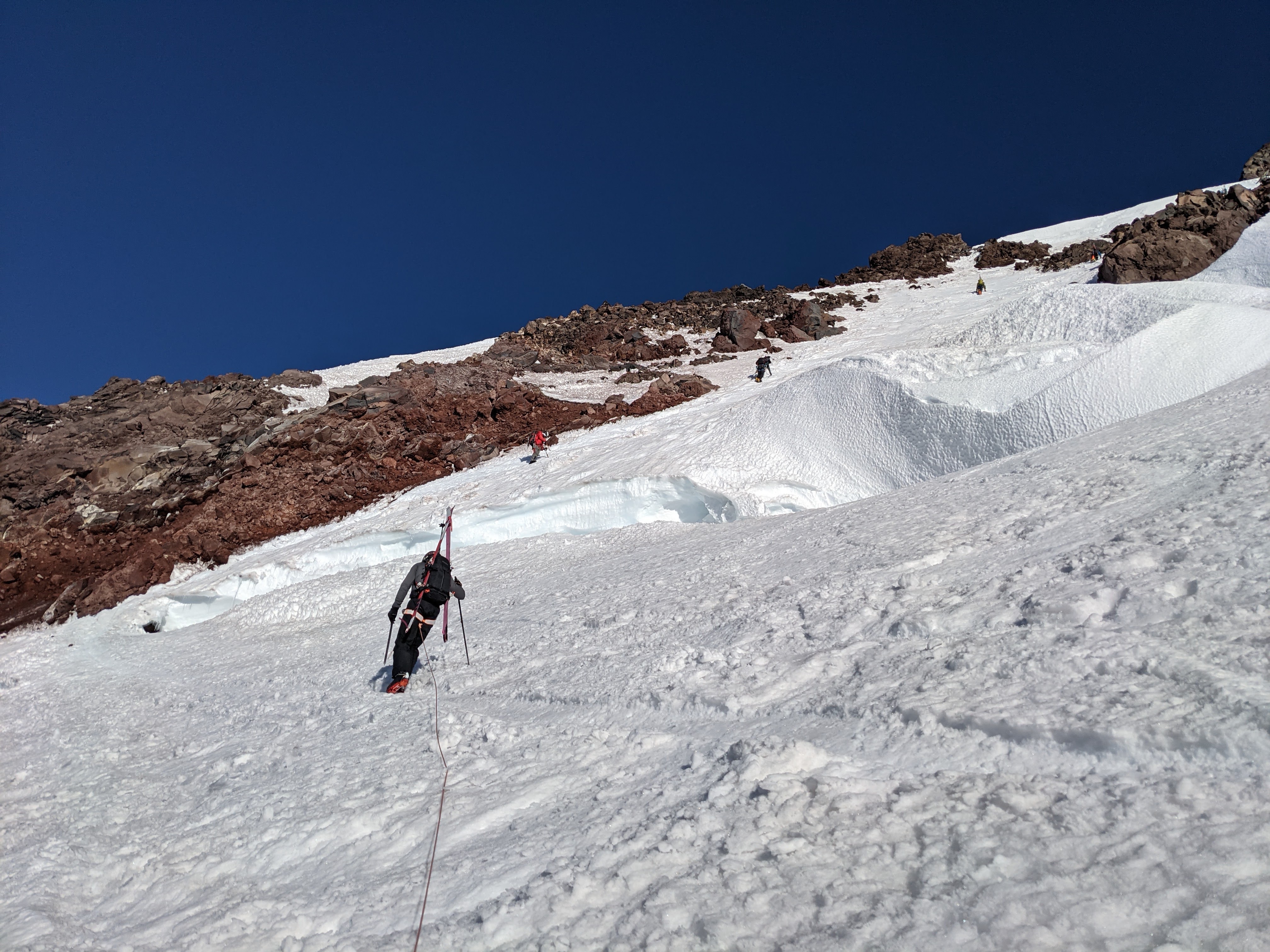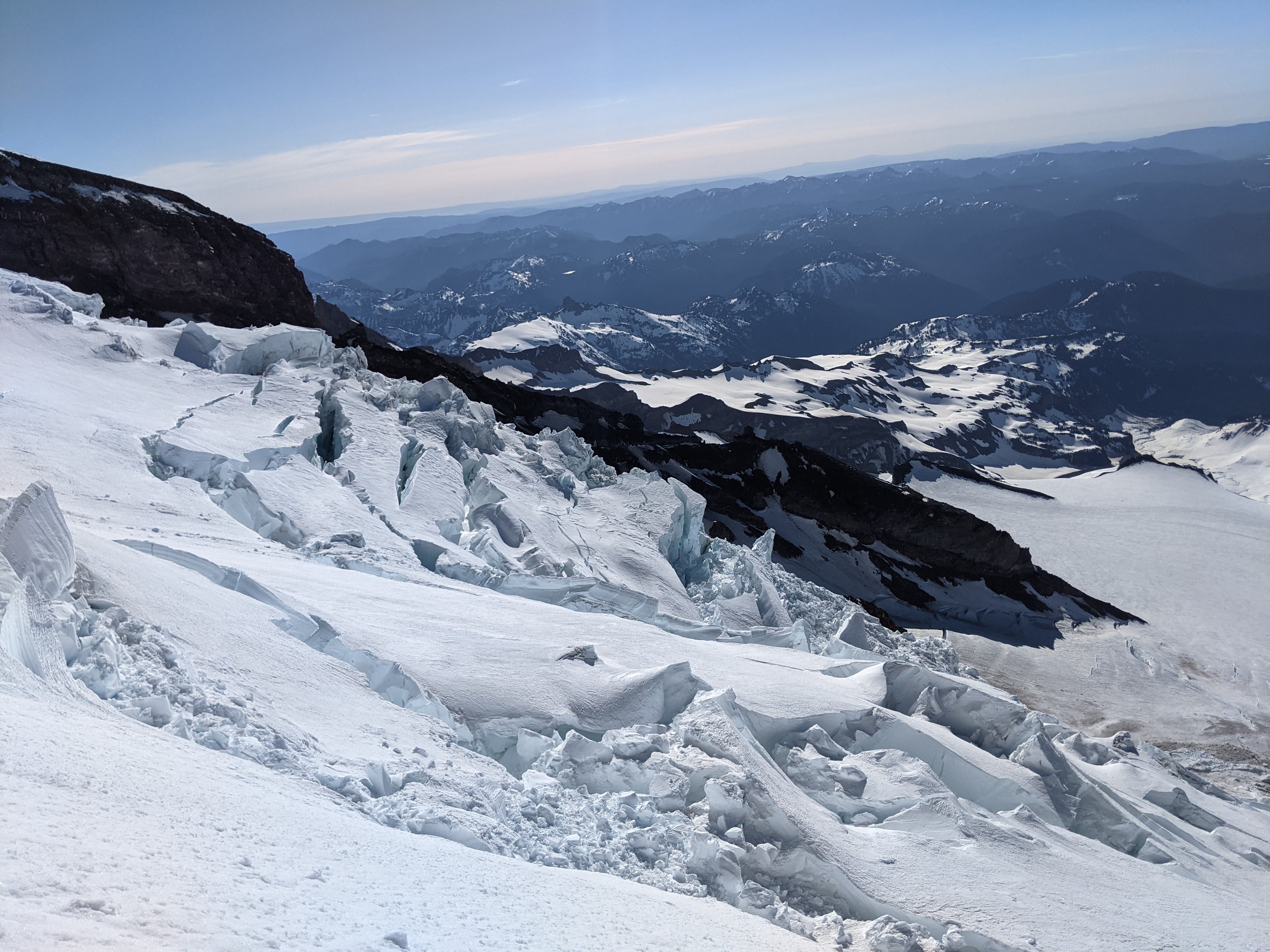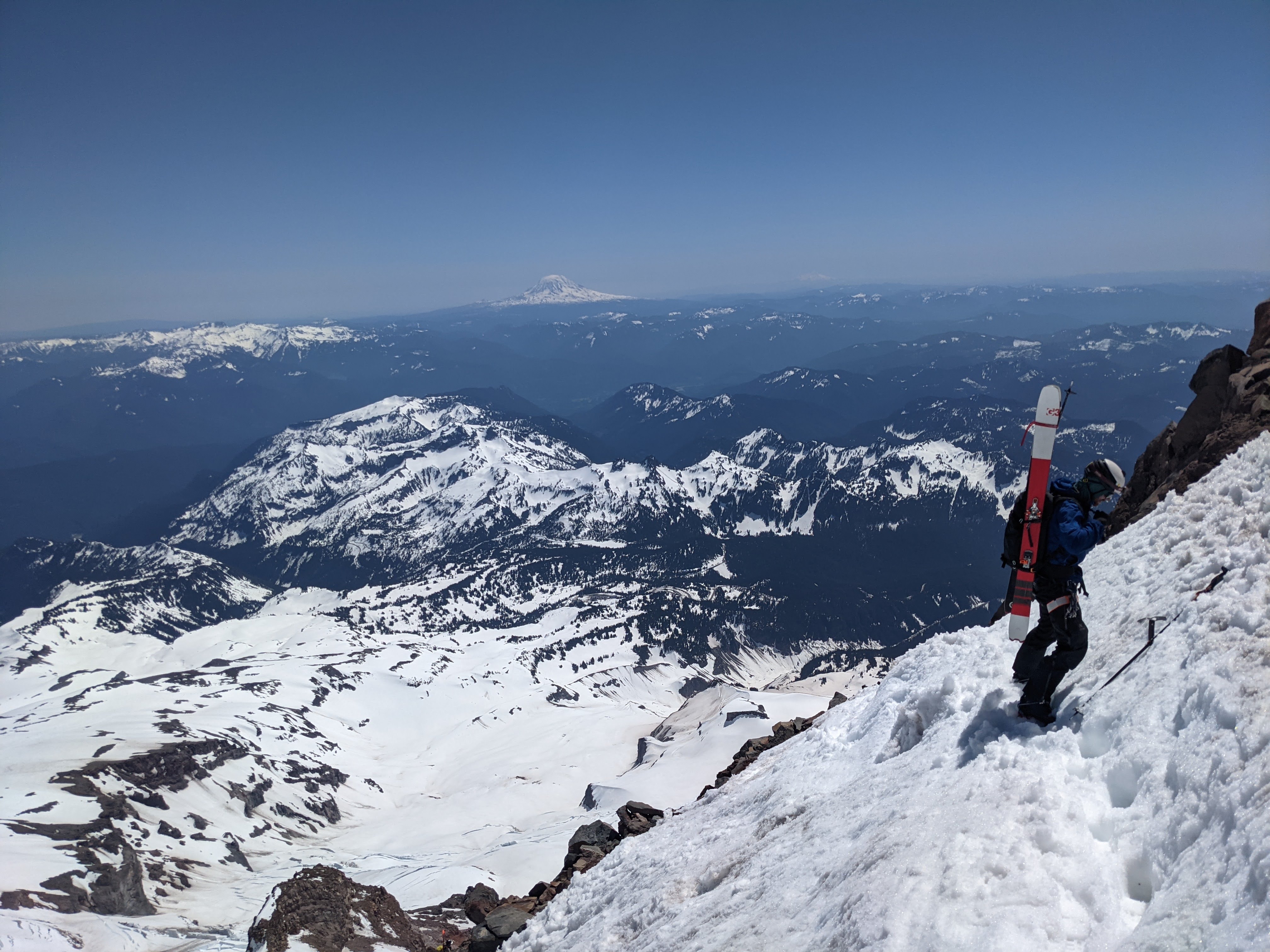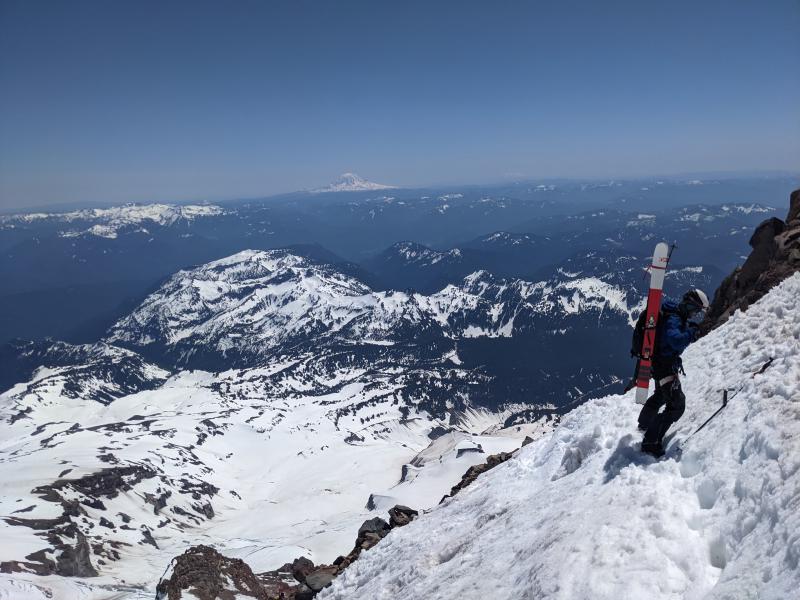After our adventures the previous weekend skiing the Cascadian Couloir on Mt. Stuart, both Bens invited me on their planned trip to ski the Fuhrer Finger on Mt. Rainier, one of the 50 classic ski decents of North America. Truth be told, I was shocked. In my mind the Fuhrer Finger held this “hardo” status, and I had it in the back of my mind as a “dream line”, an adventure I could strive to be skilled enough for one day. A nice cap-stone on my modest ski career in the cascades. Happy enough to help the Bens train for it, when they claimed I was strong enough and invited me to tag along, I was more than a little intimidated. Whether or not I actually believed them, I sure wasn’t going to pass up on an opportunity to find out.

We got to Paradise, got our permits, and starting loading up our packs in the parking lot with the sun high in the sky. We didn’t have a very difficult day ahead of us, so we took our time and enjoyed the walk through the trees with our wonky overnight packs. The sun was blazing overhead, and made the snow sticky, difficult for downhill skinning as I found out dropping down onto the lower Nisqually. It had been an incredibly hot April, which we began to take note of making our way past a few open crevasses as we weaved our way up to a crowded camp at 9000ft.
We enjoyed a beautiful sunset at camp, cooked food, and shared some good laughs before climing into bed before the sun was fully gone. Tomorrow was going to be a very different kind of day.

We woke at 2am and quickly downed some instant coffee, grabbed our bags already packed with skis for our summit day, and crunched our way across the pitch-black glacier towards where we knew the finger would begin to take us up. We illuminated a few massive crevasses on the way, reminding us the kind of place we found ourselves in. Eventually we were kicking icy steps up the couloir, looking down on the string of headlamps connecting us to the safety of camp below.

When the sun finally rose and began to warm us up, we found ourselves above the Finger and we soon were preparing to cross the bottleneck snow bridge onto the Wapowety Cleaver, which looked like it was hanging on by a thread. If the thin snow bridge didn’t scare you enough, the steep, icy, and rocky face climbing up the Wapowety Cleaver would make sure to finish the job, as it hung over the huge gaping mouth of the bergshrund marking the distinction between the upper and lower nisqually glacier. Luckily we were near the front of the pack, because the state of the crossing would eventually lead to long lines of parties carefully crossing and climbing this prearious section.

Parts of the climbing involved swinging our axes into clear ice and kicking the front points of our crampons in to get purchase. These sections felt precarious, but with the sustained nature of this section, we just had to keep moving. We were roped up, and I was leading the long pitch while the three of us simul-climbed at the same speed. In hindsight, we probably should have unroped, but when Ben slipped on the crux of steep, thin ice and weighted the rope, I’m sure he was happy to have it. Luckily, I had paused and was in a secure position with all four points in solid placements, but I continued with an uneasy feeling, making sure each stab of my axe and every step I took was solid.

The climb wandered past some very loose rock bands, with one section requiring a few third class moves on rock. The three of us cautiously moved through the section, using the rock as little as we could, as the rock quality as a whole was more than a little suspect. Just as the last Ben took his weight off the rock, it dislodged a microwave-sized chunk which hurdled down into the deep chasm of the crevasse below us.

Eventually, we stood atop the cleaver, looking down on the broken up Nisqually glacier, with only the Nisqually headwall above us. Even though the headwall involved some crevasse crossing, it was simple to navigate and we could relax a great deal. The day was getting warm, and we needed to move efficiently in order to make our turn-around time. We eventually made our way to the top of the headwall, and only the final ridge stood before us. We were tired, and in our haste and exhasution decided to leave our packs behind and head towards the summit skinning with just our skis.
Around 300ft below the summit cap, the wind buffed snow turned to solid icy chicken-heads, and skinning became incredibly difficult. Having stupidly left our crampons behind with our bags, we had to make a decision and fast. We needed to ski the Finger as early as possible to avoid the certain rockfall we would encounter in the couloir, and we were dangerously close to our turn around time. Ben started skinning and edging his way up the ice, which the other Ben decided it was too precarious and he would wait for us to summit quickly. I shouldered my skis and began kicking what steps I could up the ice. This would later lead to the loss of one of my big toenails, but I still consider it a worthy sacrifice.

Ben and I shared some two whole minutes together on the summit before clicking into our skis and skiing the chunky barbie-doll heads back down to Ben. We all skied the headwall together, enjoying great, chalky turns. In the back of my mind; however, I knew we couldn’t relax until we were down the cleaver and down the finger. We stopped atop the cleaver briefly, before dropping down onto the steep face, where one turn would drop us 60ft. We side slipped our way down, traversing until we came to the last section above the bottleneck.
We dismounted our skis and began to follow a bootpack down. I followed it down into a loose gulley, which was rapidly beginning to melt out, and I soon found myself kicking steps into more mud than snow. Without warning, a mini-fridge sized rock pulled out with me bear-hugging it, and the two of us tumbled down the short gulley that hung precariously over the bergschrund. I was able to self-arrest in time, digging my ice axe into the muddy soup that lined the walls. Ben, who had stood above, watching me downclimb the gulley, yelled down with a terrified question after he witnessed me tumble out of sight.
“Bryan?”
I called up and informed them that I was fine, and that they should find another way. I transitioned back to my skis at the bottom of the gulley, and carefully skied down the rest of the face above the bergschrund, making one quick hop-turn at the bottom to quickly cross what remained of the narrow snow bridge connection to the lower Nisqually. Overcome with relief, I watched my friends ski the same section and bridge crossing, before we all safely met on the lower Nisqually. Now all that remained was the Finger itself, and we should probably hurry.

We skied great corn down to the Finger, where we gave each other some space and tried our best to move quickly through the rockfall zone with legs burning. In our decent, there were a few sizeable rocks that came down, but not in close proximity to us. We cleared the finger, and rode pleasant spring snow back to camp. We celebrated our day, melted snow for water, and packed up camp. We skied down the lower Nisqually with heavy, off-kilter packs, and booted up the last section to return to Paradise where our car was parked.
We exploded in the parking lot, stripping off boots and laying on the hot blacktop. The three of us were smiling ear-to-ear, cracking jokes and absolutely brimming with the kind of joy that can only come from returning to safety after a harrowing experience.
I learned a lot through this experience, and a lot of the conditions we encountered on the cleaver left me deeply unsettled. I vowed never to attempt a serious line in such melted-out conditions ever again, and shifted a lot of my acceptable-risk beliefs that day. In the subsequent days after this trip, I would reflect on what I previously thought would be a career topping achievement, completed at the end of my second season knowing how to ski. As I thought forward to more skiing to come, I couldn’t help but wonder: “What now?”
